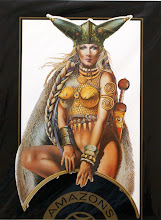From November 1954 when his first strip appeared in the UK, Jesús Blasco carved an astonishing path through British comics, producing some of the most popular stories of their times. British strips often played fast and loose with historical facts and physics and grounding them in Blasco’s photo realistic artwork made them believable to their youthful audience. His artwork inspired a generation of new artists, Dave Gibbons and Brian Bolland both acknowledging his influence.
Jesús Blasco Monterde was born in Barcelona, Spain, on 3 November 1919, one of five siblings—brothers Alejandro, Adriano, Augusto and sister Pilar—who, to one degree or another, all worked in comics. Entirely self-taught, Blasco began working professionally in comics shortly after his first prize-winning drawing appeared in Mickey when he was 14. Only 15, he created ‘Cuto’ for Biloche in 1935. The boy hero become one of Spain’s most popular comic creations following his appearance in Chicos in 1940 and Blasco added a second popular strip to his CV when he created ‘Anna Diminuta’ for Mis Chicas.
Blasco was called up to serve during the Spanish Civil War and, after the war, served three years military service whilst still managing to keep up a steady output of comic strips from war stories to nursery tales.
In 1954, he made his debut in the UK and continued to contribute to British comics for over 20 years. From drawing ‘Buffalo Bill’ and ‘Billy the Kid’ in Comet and Sun, Blasco took over the artwork of those most British of heroes, ‘Robin Hood’ and ‘Dick Turpin’. He also turned his hand to fairy tales, drawing beautifully painted spreads for Playhour featuring Pinocchio, the Dancing Princesses, Rumpelstiltskin and others.
In 1962 he drew ‘Vengeance Trail’ for Eagle and, that same year, began work on his two longest-running strips: the darkly menacing adventures of ‘The Steel Claw’ in Valiant and the whimsical children’s fantasy ‘Edward and the Jumblies’ for Teddy Bear.
Thanks to inking help from his brothers Alejandro and Adriano, who did not receive any individual credits in the UK after 1955, the Blasco family were able to turn out an astonishing number of pages each week with no fall-off in quality.
In 1968, Blasco adapted ‘Montezuma’s Daughter’ for Look and Learn and went on to draw further features and stories for that paper and its companion, Treasure. In the 1970s, he also drew the adventures of ‘The Wombles’ and ‘Return of the Claw’, but the market in the UK was no longer able to absorb his output. In 1968 he had drawn ‘Los guerrilleros’, written by Michael Cussó, for Spirou. Now, in 1974, he became more heavily involved in the Portuguese comic Jornal do Cuto and the Spanish comic Chito and his output in the UK fell away. Apart from a few episodes of ‘Dredger’ in Action and the opening three episodes of ‘Invasion’ for 2000AD, Blasco turned his sights to Europe, where he was invited to adapt the Bible as a series of comic strips.
In 1982, Blasco was awarded the prestigious Yellow Kid at Lucca and the French honorary award Ordre des Arts et des Lettres. In 1986 he worked with Victor Mora on reviving ‘El Capitán Trueno’ but the strip was caught up in the collapse of its publisher. Blasco turned to Italy and Bonelli’s long-running western saga ‘Tex’ and science-fantasy ‘Zona X’. He also teamed up again with Victor Mora to recount the historical adventures of ‘Tallaferro’.
Blasco died on 21 October 1995, survived by only one brother, Adriano.
Examples of Jesus Blasco's artwork can be found for sale at the Illustration Art Gallery.
Subscribe to:
Post Comments (Atom)






















No comments:
Post a Comment